Question
(a) Fig. 1.1 shows the human heart and the main blood vessels. The functions of the parts of the
heart and some of the blood vessels are given in Table 1.1.
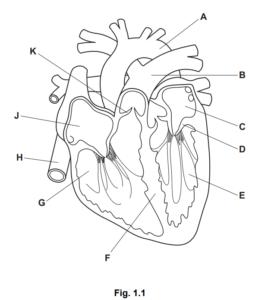
Complete Table 1.1.
One row has been done for you.
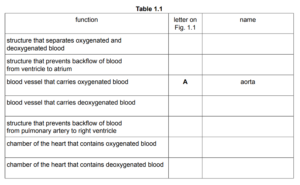
(b) A group of students used a heart monitor to record the pulse rate of an athlete during a 5000
metre race. The recordings started just before the race began and ended just after it had
finished, as shown in Fig. 1.2
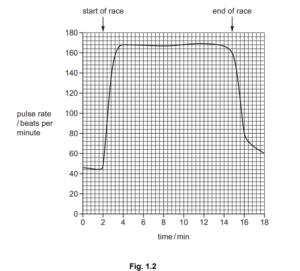
(i) Use data from Fig. 1.2 to describe the effect of exercise on the pulse rate of the athlete.
(ii) Explain the change in pulse rate between 2 minutes and 3 minutes after the recordings
started.
Answer/Explanation
Ans
1. (a) 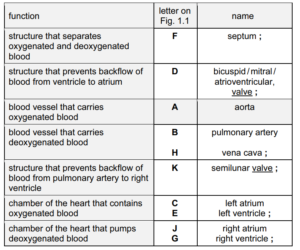
(b) (i) pulse rate increases and remains constant ;
immediate/sudden/steep/rapid/AW, increase in pulse rate ;
increases from 44–48bpm to 164–170bpm ;
maximum/164–170 bpm, at, 4 min(utes)/ 2 min(utes) after race starts ;
(ii) adrenaline stimulates increase in, heart/pulse, rate ;
increase in blood, carbon dioxide (concentration)/acidity, detected ;
nerves stimulate heart to beat faster ;
ref to muscle contraction/AW ;
muscles require more energy/muscles are doing more work ;
(rate of aerobic) respiration increases ;
increase demand for, oxygen/glucose ;
ref to removal of, carbon dioxide/lactic acid/heat ;
more, blood/carbon dioxide, to lungs (per unit time) ;
more, blood/oxygen/glucose, to muscles ;
AVP ; e.g. ref to ATP/vasodilation in muscles
Fig. 1.1 shows a vertical section through a human heart and the major blood vessels.
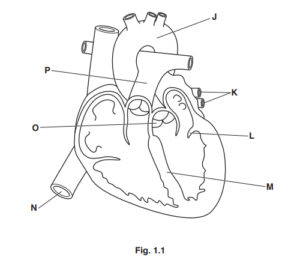
Question
(a) (i) State the names of the structures labelled L, M and O as shown in Fig. 1.1.
L …………………………….
M …………………………….
O …………………………….
[3]
Answer/Explanation
Ans:
L – atrioventricular valve ;
M – septum ;
O – semi-lunar valve ;
Question
(ii) Identify a letter on Fig. 1.1 that represents a blood vessel that has:
blood with the highest concentration of carbon dioxide ………..
blood with the highest concentration of oxygen ………..
the highest pressure ………..
[3]
Answer/Explanation
Ans:
N/P ;
J /K ;
J ;
Question
(b) (i) Describe how blood is moved by the heart from blood vessel K to blood vessel J.
………………………………………………………………………………………………………………………….
………………………………………………………………………………………………………………………….
………………………………………………………………………………………………………………………….
………………………………………………………………………………………………………………………….
………………………………………………………………………………………………………………………….
………………………………………………………………………………………………………………………….
………………………………………………………………………………………………………………………….
………………………………………………………………………………………………………………………….
………………………………………………………………………………………………………………………….
………………………………………………………………………………………………………………………….
…………………………………………………………………………………………………………………………
[5]
Answer/Explanation
Ans:
1 blood from pulmonary vein /K, enters left atrium ;
2 atria contract ;
3 atrioventricular valve / L, opens due to pressure from blood ;
4 blood forced into left ventricle ;
5 ventricle contract ;
6 atrioventricular valves / L, shut to prevent blood entering atrium ;
7 semi-lunar valves /O, open ;
8 blood forced into, aorta / J ;
9 AVP ;
Question
(ii) Explain why the wall of the left ventricle is thicker than the wall of the right ventricle.
………………………………………………………………………………………………………………………….
………………………………………………………………………………………………………………………….
………………………………………………………………………………………………………………………….
………………………………………………………………………………………………………………………….
…………………………………………………………………………………………………………………………
[2]
Answer/Explanation
Ans:
eft ventricle wall contains more muscle ;
left ventricle pumps blood further ;
left ventricle has to overcome more resistance ;
left ventricle pumps blood at higher pressure ;
